


策展人:王尤
出品人:刘晓都
展览研究员:陈颋、陈柏麒
开展时间:2022.12.24
地点:坪山美术馆6层
地址:坪山美术馆
指导单位:坪山区文化广电旅游体育局
主办单位:坪山美术馆
执行团队:坪山美术馆团队、万尤引力实验室
展务执行:振世远景艺术展览
一个没有建构终结的星群
蒋志展览《刻舟的人》策展研究
文/策展人 王尤
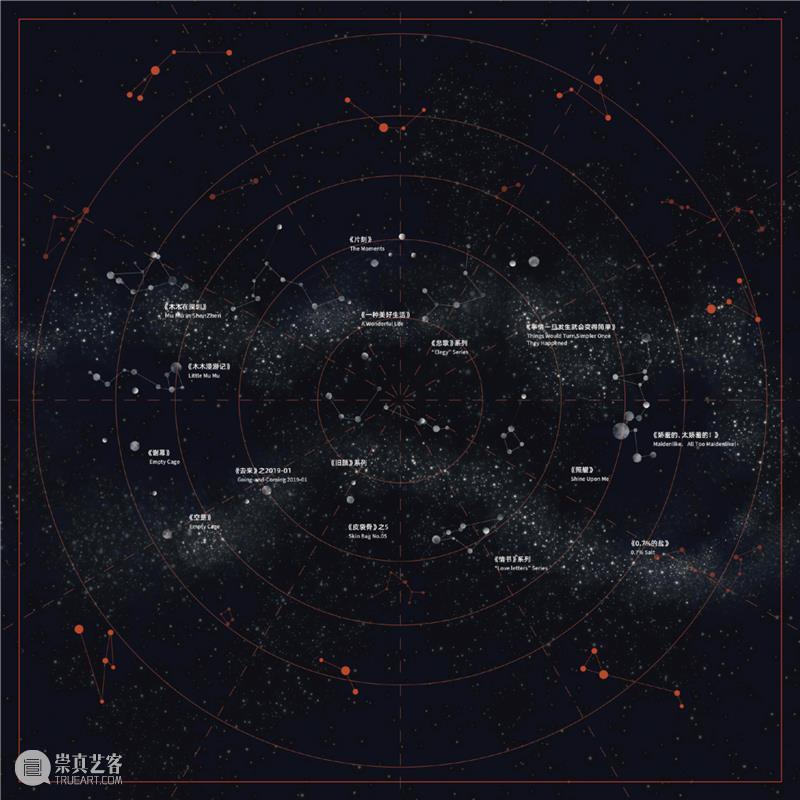
策展概念图“星群”/王尤
展览宇宙
自十九世纪以来,现代美术馆以其纯粹、明亮、中性的空间构造确立了一种“规范的”公共展示——观赏制度,不同类型的艺术实践皆可在这个圣殿般的空间中呈现为 “作品”。而后的很长一段时间, “白盒子” 被认为是一种分离, 将所有作品与它原本发生的生活世界分离;将创作情境与观赏情境分离;将审美体验空间与日常体验空间分离。同时,这样的认定也被消费文化直至网络文化同构异化,奔向使人获得积极性享受和触屏可及的 “平滑” 空间。伴随着观众的体验和出镜强行挤进作为 “特定的凝注——沉思的意义空间” (这也是 Muse 女神庇护下的 Museum 的源初涵义) 的过程,似乎一切呈现都是为了成为另一重界面里的美貌佳肴。在网络媒介的转译之下,展示本身与观众的身体一同被打包,进行再展示。“观赏制度” 在进行上述分离工作的同时, 也被穿刺进社交界面的腔体, 伴随作品与观众的 “亲密关系”,消解被观看主体凝视和思考的意义。如果将视觉压力与直接触觉和动态压力分离,将作用于对以上情态的改变吗?前提有是一种新的延伸在人的所有感知和官能中建立起一种新的平衡,造就我们所谓的“新观点”、“新态度”甚至“新偏好”。
召唤观看
蒋志个展《刻舟的人》希望用改变展式空间的方式使“观看”以新的外貌构成新的展览概念,在展览宇宙中开辟一条隧道,用缩小观众身体空间并调暗亮度的方式重构“观看”行为。在这里,作为人类官能延伸的电光照明,也给我们提供了一个最清楚明白的例证,它说明着我们的感知是如何被改变的:地球先民像宇宙器官一样行动,把人体功能当作参与宇宙之力的形式。暗夜限制了地平线行为,却开启了投射目光向星空的行动,当然也强化了星空作为对象的意义。而后,电灯一亮,就出现了一个新感知的世界……
姑且可以称我们将置身于一个展览宇宙——面孔、言语、童话和渴望的具体化身。它的形态或许需要嵌入宇宙秩序在身体器官和社会延伸中的循环往复的再现。在这个召唤观看的装置里,观众不能走近作品,但可以走进作品。一根根笔直的目光鱼线,从眼直接跳转至意。
蒋志长期保持随时记录周遭事物的习惯,这特别在他持续多年的系列作品《片刻》中有充分体现。他的友人曾形容 : “一个庞大的身躯正呼啸着往前赶着路,以史无前例的速度改变着自己。而一个人(蒋志)却那么执著地拍摄着这个过程中微弱的细节。” 艺术家在用拍摄的方式进行观看, 本展览也希望重现艺术家创作里的 “对观看的观看”;塑造一个个纵情延伸眼睛去包容旧的现实的姿势, 塑造一个产生新的意识的空间。
墙里的时间
当观者的目光以c=299792458m/s的速度到达作品,那就意味着所见之物已滑进过去的时间中。那么展览所设置的一道观看之墙就是对时间流逝的凭证。正如我们都知道,观之星象,皆为旧星,一切面孔,皆为 “旧颜”。所有观察到的现状都是过去的既有事实,所有此刻发生的事实影响的都是将来。这道凭证里存在着我们的过去——在现在所见之前发生的事件;存在着我们的未来——在此时此地我们所见之后会发生的事件。在过去与未来之间,还存在着一个时间段,它既非过去,亦非将来,有一定的长度,却没有统一的长度标准——这也是延展的现在。
然而有多少种生命,就有多少种时间感觉。这也是现代物理学家和科学家对时间的感觉。他们不再设法把事件限制在时间概念之中,而是认为每样事物都有自己的时间和空间。而且,由于我们借助电力媒介生活在信息瞬息万里的世界中,所以空间和时间就在一个时空世界里相互渗透。那么在这样的量子干扰中,有多少观众,就有多少种“时间感觉”,就有多少种“旧颜”。莎士比亚的十四行诗里大量描写了这个被不断出现的新媒介所压缩的行星的“古怪”——“印刷手段所赋予的万世不朽的美名和时钟计量的日常生存的庸碌委琐:当我数着壁上报时的自鸣钟,见明媚的白昼坠入狰狞的夜……于是我不禁为你的朱颜焦虑:终有一天你要加入时光的废堆。”( 十四行诗第十二首 )。而对于另一个诗人,时间之于可爱的恋人相似却并不相同。安德鲁·马韦尔的长诗《致羞怯的情人》中有:“假如我们有足够的天地和时间,你的羞怯,我的爱人,岂能是罪孽……凝视你的前额要用一百年的岁月……至少要一个时代洞悉你的心田……”可见机械钟表借分秒的划分,在我们的时间感觉上强加了统一的时间接续性。
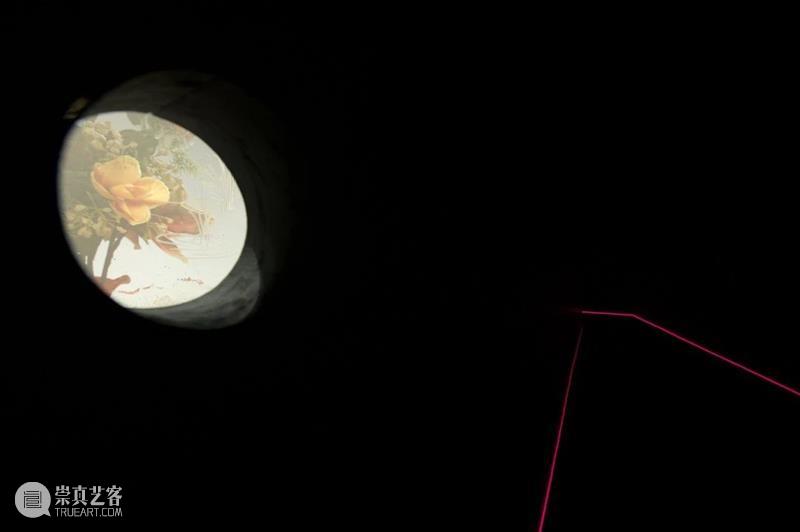
展览现场“旧颜”
刻舟
在蒋志故事里那个 “刻舟的人” “找老渔夫借了一把小刀,在船边剑掉落的地方刻上一道。” 然而,他 “明知道在那里刻上一个记号是徒劳的,但是这种记录本身——他刻下:是从这儿失去的。这种行为本身是完成一件关于信念的事情。这个失去的事件需要被铭记。”(蒋志,《刻舟的人》)
“识字的人”总会被讽刺为他们一向喜欢“惊诧地看”或“骄傲地指出”, 同时又小心谨慎地忽视眼前发生的事情。这里麦克卢汉所说的“无处不在的无知觉”似乎起到了某些作用。然而,蒋志却习惯于“刻下”,不光是记录下周遭的片段、 稍纵即逝的表情、 行为社会的他者投射,也是用绘画、摄影、录像等方式留住的某种状态,用图像获得另一种意义的行为,发生另一种真实,为了平息……或可说,本次展览是由被刻下的意义所组成的聚集体。
或许,蒋志录像作品《礼物》(非本次展出)里的那只任沙流走、任光照耀的张开的手似乎也是刻舟的手。刻舟人掉剑之后也曾试过“趴在船边,伸出手去捞,他的手上只有水而已,他看着自己湿漉漉的手心,水珠从手指上滴落下来。”那时,他已清楚,只有刻下(记录下)可以铭记,那剑,那光,那沙,那礼物,不可拥有,不可送出,但可铭记。
“刻”作为媒介
然而,当把“刻”(或记录) 作为媒介来看待,它的逻辑就不是口语的逻辑,也不是句法的逻辑。作为一种讯息,“刻下” 是内心欲望表达的一种延伸,同时引入了新的看待过去和记忆的尺度,使每一个“当下”被填充入具体的时间而具备了独一无二的行动能力。把这场行动本身作为媒介来看待意义还在于,我们如何看待“做记号”到“储存欲望”间的转换,是刻舟求剑到刻舟不求剑的转变,这一个新的转变机制的建立。这一动作媒介更主要作用于意,而非眼、耳、鼻、舌、身……它扰乱直线时间的幻觉,改变目光的方向,从而在当下的语义潜能中挖掘过去的记忆。
打个比方,摄影动作在使人的感性知觉发生的彻底转换的过程里,伴随自我意识的发展。无论在公开还是私下场合,它能改变人的面部表情、化妆和身体姿态一一它也影响我们的内心姿态和自我对话(意)。而当意识到荣格和弗洛伊德的时代就是摄影的时代,自我苛求态度的时代,那么,那个宏大的内心生活的梳理过程受到了新型图像完形文化的推动就顺理成章了。这么一说就更容易理解,媒介本身作为一种力量对人内在的影响。在《娇羞,太娇羞的!》《0.7%的盐》等作品中,摄影、录像、新闻、网络……等媒体内容以转译者、放大器等身份出现在作品人物的影子里,甚至掠过面孔的风头,变成意义的主人。因为媒介的本质是一种“讯息”,它高于“内容”,不光是媒体对个体内部的影响,在人们布置生存空间(如住宅、城市等)的努力中,显而易见有与之平行发展的东西,甚至看见贫民窟的照片也会使人觉得不能容忍。“讯息” 对社会结构有着强烈的刺激作用,甚至能够肢解和重构现实。这些问题也在摄影作品《一种完美生活》和录像作品《诗意》(非本次展出)等作品中有被照耀过。仅仅是照片与录像里的内容与现实相匹配这一点,就足以给接下来的变化提供新的动力,正如它给人的旅行提供新的动力一样。媒介作为我们身体和神经系统的延伸,构成了一个生物化学性的与社会性的相互作用的世界;因为新的延伸在不断发生,个体乃至世界必然要永不停息地谋求新的平衡。
“刻”下的电光石火
电力和光的杂交,促使“电光”产生,“电”和“光”都是没有“内容”的媒介,却对人类社会的改造作用不言而喻。新的需要和新的技术回应不断累积,最终导致的并非传统的外爆,而是一场空前的内爆。蒋志在他的短诗中曾使用“没有羞涩的”来形容进入各种房间的光。到了电子媒介时代,人们可以储存和转换一切,速度根本不成问题。在这个意义上,时间对于一个全球社会不再重要,因为没有什么会停止,也没有人会停止。我们不能更具身的体会宋代释普济在《五灯会元》中说“此事如击石火,似闪电光”了。
是的,电速的内爆,之所以不能叫作光速的内爆是因为我们还未能突破光障。内爆使宇宙初开,内爆使人猿相揖别,内爆使生死两相别……它消解时间概念,消解原本的存在状态,消解人的固有认知。在作品《照耀》、《事情一旦发生就会变得简单》、《悲歌》、甚至是《情书》等作品里,电光石火的出现也似让我们去体会一场超越时间概念的“爆破”。单独欣赏这些被形成的“蘑菇云”的面貌确实是美丽的,只要不去考虑隐形辐射……因为人类打内心厌恶去理解自己被卷入的过程。
何况,《刻舟的人》 意在打开了一个记忆的价值空间,不愿意看到历史记忆变得残缺,他收集可能会被遗忘的被时间熄灭的石火。蒋志试图在对片刻的采集中抵抗记忆的流散和毁灭。收集片刻的电光,并非要恢复一种有序的时间,而更倾向于相信一种拼贴的时间,这种时间体现于各种事物之间的混乱、散点式的并置。静态的有序时间无法面向过去凝聚在一个焦点上的特殊状态,反而会对当下时代的命运感到冷漠,也就无从感知电光石火通过记忆对当下发出的信号,释放更多的语义潜能。

展览现场“娇羞的,太娇羞的!”
星群
“我们觉得我们拥有。但其实——也可以这么去理解——我们并没有真的拥有——这一切。”
“过去之剑不可得,未来之剑不可得,现在之剑也不可得。”
“这个失去的事件需要被铭记。既然需要铭记,没有比在遗落之处留下一个印迹更合适的地方了。”
“去做——获不到这一种意义的行为,去获得另一种意义。”
(蒋志《刻舟的人》)
关于过去、现在和未来
宇宙的墙上没有一台挂钟来给众生规定一个统一的标准时间。每个人,每个物体都怀揣着各自的怀表记录只属于自己的时间,且它们还会随时因自身的速度和受到的引力而不停改变。这也许是爱因斯坦的相对论讲述的最深刻的一件事了;哪怕在牛顿物理学中,也不存在单一普遍意义的“现在”。我们永远也无法找出任何一颗“现在”的星星,甚至连“现在”这个词本身都是没有意义的。之所以会有“同在一个现在”这样的错觉只是因为我们离身边的人距离太近,但真实的情况是即使对于站在你眼前的人,你此时此刻看到的也仅仅是过去的他(虽然只是几纳秒前的过去)。正所谓古人不見今時月、今月曾经照古人。询问“你现在在干嘛”就如同询问“三体星的深圳在哪儿”一样没有任何意义。人类对“未来”或“过去”的共同理解可能并不适用于宇宙中的其它地方,但确实反映了地球上的现实生活。
并非像恒星天永恒不变的,除了现在,更有感觉和记忆。况且后人证实,古人认为的恒星天也并非像天花板上的壁纸一成不变。作为人最初级的认识活动,感觉通过各种感觉器官收集和接受外界信息,在脑中产生的对事物的个别属性和特性的反映。过去的记忆并非一个巨大的视频库,我们利用它来检索生活中的事件记录。事实是,我们改变记忆,使之更有意义。每当我们回忆起一段过往,我们就会在脑海中重新构建这些事件,以适应任何可能出现的新信息。而这所有的基础,就是我们善变的感觉。负责任的讲,如果只是单纯想看到过去,那么应该抬头仰望星际。“我们返回去故乡, 去寻找什么?谁都知道我们无法寻回已经过去的那一部分生命。但你仍然要去寻找,这种行为一定要发生,这是你生命中的一种欲望,我们就是因为去做这种明知不会有那种结果的事情,去获得另一种东西。”
没有建构终结的星群
如何体现“去获得另一种意义的”状态?
展览希望能够建立起一种目光和所思的具体对象之间的关系。不是强制的关系,而是像星星一样松散却又是联结着的关系。与现代主义的“蒙太奇”相似,展览使过去的事件与过去的事件相联系,或是与现在相联系。它作为一种历史发展的映像,体现了从“童话”到历史观念的变迁。各个星星之间是独立的,但是它们之间又构成一个整体的星座,正是它们之间的这种关系保证了每一颗星自身的独立和本真,从而能够与其他的星星之间产生不可估量的引力和张力,显现它们之间平等的并置关系,它们互为隐喻和寓言的关系,相互吸引和影响的关系,相互撞击、斗争的关系,但不是相互妥协、或兼并的关系。
不过,作品间的联系也是对展览总体化力量的反对,或可以将这种反对视为一种辩证模式。展览中,并不希望作品中的元素或事件所体现的是它们直接表达的东西(如历险的小木偶、燃烧的花朵或哭泣的女明星等), 相反, 联系本身形成了一个网络或空间, 在它内部, 不断发生着变化的元素是平等地处于同样地位的,并非具有某个中心。正如每个星座内的星星,它们共同形成了星座的图像,没有哪一颗星比其他的星更重要。 也是在这个意义上,展览的星群构成,是去体系化的,它关注了任意作品的特殊性。这种作品关系形成了一种力场,观众在其之上,通过展览各部分之间的互动交流和互补激活了内在于它本身的特质和活力。同时,当这个构成方式本质上看起来是一种语言的时候,成为一种不定义概念的再现形式,但通过将围绕一个事物的概念放在关系当中来赋予它们新的意涵。
在展览之中,“刻舟的人” 并不是被当作一个孤立的客体,也更不是一个总和;相反,它被置于一个强调与其他概念之间的相互联系和作用的力场之中的一个单位,一个作为自由开放过程的客体。作为一个反体系,展览的空间特征可以解释它的各个组成部分之间非线性的张力,用构建一个力场来思考非同一性,这个力场是历史性的个体之间所建立的不固定的和平共存的关系。希望用此模式将展览思想从固定的范式中解放出来,开启一系列的可能性。比如,一个交互关系构成的运动,一个不断地更新自己的意义域的观看行为,一个有无数把钥匙的保险箱,一个没有建构终结的星群。

策展概念图“观看装置”/王尤

A Constellation Without Termination
Curatorial Preface of the Exhibition of Jiang Zhi: The Man Who Carves the Boat
By Wang You, the Curator
The Universe of Exhibiting
Since 19th century, the modern museum has built a "norm" for public exhibition and appreciation with its pure, bright and neutral spaces, in which different kinds artistic practices can be presented as "works" in these temples of art. For a long period afterwards, the "white cube" is recognized as separation, the one between the works with the living world where they resign, the one between the situations of creating and appreciating, and also the one between the spaces of aesthetic experience and daily experience. At the same time, this definition is merged but also foreignized by consumer and cyber cultures, making the cube a "flipping" space that enables people to actively enjoy, even through the touchscreen. In the process accompanied by the viewers' experiencing and exhibiting, the "meaningful space of particular gazing and speculating" (the original meaning of "museum" in the name of Muse) is narrowed. The presentation of everything now aims to become the beautiful pictures in other screens, which, in the translation of media, is then being represented, together with the viewers' physical existence. The "appreciating system," while performing its duty to separate, penetrates into the social interface accompanied with the "intimacy" between the viewers and the works, and resolves the meaning of the gazed and the related thinking. Will the abovementioned modality change if applied with another separation between visual pressure, direct touch and dynamic pressure? The premise for this should lie in a new extension which drives the balance in all the senses and functions, creates the so-called "new viewpoints" and "new attitude", and even builds a "new preference" for us.
Calling for Viewing
The Man Who Carves the Boat, Jiang Zhi's solo exhibition, hopes to reform "viewing" into a new exhibiting concept by way of changing the exhibiting space: in the universe of exhibiting, a new channel is dug out for reforming the action of "viewing" by minimizing the physical spaces taken by viewers and dimming the lights. Here, the electronic lights, the extension of human function, exemplify as a simple case for us to understand how our sense is changed: the earth takes actions as an organ in the universe, where human functions are treated as ways to merge into the power of universe. The dark night, while limiting the actions of the horizon, leads our eyes to the starry sky, which, obviously, emphasizes the meaning of the starry sky as the target. Later on, the electronic lights are turned on, highlighting a new world of senses…
Let's say that we are now in a universe of exhibition, with the embodiment of faces, languages, fairytales and desires. Its form may need installing by a universe order before it can reiterate in the cycle of human physical organs and social extension. In this installation calling for viewing, the viewers though stop far off the work, but rather step into the work. There, the lights of gaze, one after another, are shed directly into the ocean of meaning.
Jiang Zhi keeps recording the things and events around him, which is fully demonstrated in his long-term series Moment. He is so described by his friend: "In his giant form, he keeps changing himself at an unprecedented speed while roaring forward alongside the road. At the same time, he insists on photographing the subtleties found during the process." The artist views the world through photographing, which becomes the theme of this exhibition, namely presenting the "viewing on the viewing" in artistic creation. In this process, multiple eyes of extension are created to embrace the traditional real-life forms; a new space for consciousness is shaped.
The Time in the Wall
The sights of the viewers' reach the works at the speed of c=299792458m/s, indicating that the views are already those in the past. Then, the wall of viewing in the exhibiting symbolizes the passing of time. As is in our minds, the stars in the eyes all show to us in their past forms; the facets that we see all show to us in their "familiar faces". The status quo that we observe are the facts of the past; the events that are happening exert influences only on future. Upon this wall of symbol, our past is shown - the events that happened before the current viewing; our future is shown - the events that are about to happen after the current viewing. Between the past and future, another interval, neither belonging to the past nor to future, show its existence: it harbors a period of time, but without a period of certainty - this is the extension of the present.
Yet, the number of lives determines the number of perceptions of time, which is the one defined by modern physicists and the scientists alike. They no longer define events by the concept of time; instead, they believe every single entity has its own time and space. What's more, as we live in a world with information changing constantly that is enabled by electricity, time and space merge into each other in this world. Under such quantum interference, each viewer enjoys his/her own "perception of time" - and his/her own "familiar face". The "peculiarity" of this planet - the name of immorality brought about by printing and the mediocrity in daily life brought about by the counting of clocks - generated by the pressure of mushrooming new media is fully descripted in Shakespeare's Sonnet: "When I do count the clock that tells the time, and see the brave day sunk in hideous night…Then of thy beauty do I question make, that thou among the wastes of time must go (Sonnet 12)." However, another poet describes time in a similar but different way as his lovely lover, as in Andrew Marvell's long poem To His Coy Mistress: "Had we but world enough, and time, this coyness, lady, were no crime…An hundred years should go to praise thine eyes, and on thy forehead gaze…And the last age should show your heart." In this way, a unified time continuity is strengthened in our perception of time with the help of mechanical clocks which divide time into slices.
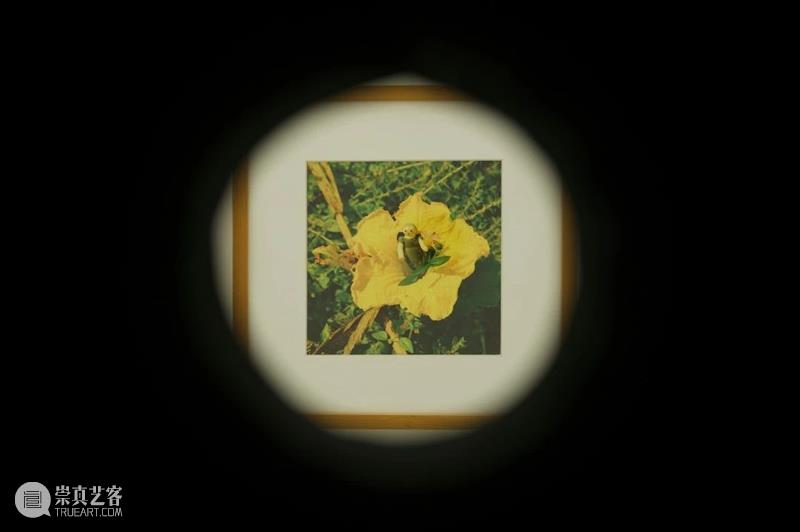
展览现场“木木漫游记”
Carving the Boat
In Jiang Zhi's story, "the man who carves the boat" "borrowed a knife from the old boatman and made a notch where the sword fell from the boat. " He "knew clearly that it was futile to carve a mark on the boat. But the notch itself was a record. He carved it to remind him that this was the place where he lost it. This behavior was about completing a deed of faith. The lost thing needs to be remembered." (Jiang Zhi, The Man Who Carves the Boat)
"The literate" is often described ironically as being prone to "look in amaze" or "point out in pride"; but they tend to overlook what is going on in front of their eyes despite their scrupulousness. McLuhan's "impercipience of the ubiquitous" may apply to this situation. However, Jiang Zhi is prone to "carve": he not only records the episodes surrounding him, the transient facial expressions, and the projection of social behaviors, but also keeps some status down by way of drawing, photographing and filming - he tends to grasp meaning through the pictures, to generate a different kind of truth, or to appease… In other words, this exhibition is aggregated with carved meanings.
Or, the opening hand in his video work Gift (not exhibited this time) which grasps neither sand nor light is for carving the boat. The man who carves the boat, after losing his sword, "bended over the side of the boat and stretched his arms into the river, trying to get his sword back. But nothing remained in his hands but water. He stared at his wet palms and saw water-drops dripping from his fingers." At that time, he knew that only carving, or recording, can engrave: to engrave the sword, the light, the sand, the gift. They can never belong to anyone; they can never be sent to anyone; they can only be engraved upon the mind.
"Carving" as Medium
Nevertheless, if we view "carving" (or recording) as a kind of medium, we should not understand them in the logic of speaking, nor the logic of syntax. As a kind of message, "carving" serves as the extension of the inner desire. At the same time, with the injection of the new measurement to view the past and the memory, it fills every piece of "the present" into the slot of time, making it unique in action. Taking "carving", the action, as the medium also matters to how we consider the shift from "marking" to "conserving desire", or the shift from "carving the boat for the sword" to "carving the boat, but not for the sword". This signifies the establishment of a new shift mechanism. This action medium functions more on the meaning, rather than the eye, the ear, the nose, the tongue, or the body… It disturbs the sequential movement of time and alters the direction of sights, which enables the past memories to be dug out of the current semantic potentials.
For instance, the action of photographing, in its process to shift the sensation, promotes the development of self-consciousness. No matter in public or in private, photographing changes the targets' facial expressions, makeups, and postures - it also casts influences on our inner status and enables inner dialogues. Once we realize that the times of Jung and Freud, the times of self-demanding, share the same features with the time of photographing, we will be able to comprehend why the grand process of untangling inner life is strengthened by the culture of new pictorial gestalt. In other words, medium, as a kind of force, casts influences on the human inner world. In such works as Maidenlike, All Too Maidenlike! and Salt of 0.7%, photographing, videos, news, networks and other media show themselves as translators and magnifiers in the shadows of the characters; some of them even surpass the target faces and become the masters of meaning, for the essence of medium is "message" which assumes a higher rank than the "content". In addition to its influences on the inner world, we can scarcely find its parallel in human's efforts to arrange the living spaces (such as residence and cities), as evidenced by a case of our intolerance towards the photos of slums. "Message" stipulates strongly the social structures to the extent that it can dismantle and reconstruct reality. This is addressed in the photographic work A Perfect Life and the video work Poetics (not exhibited this time). The mere matching between the contents in photos or videos and the reality will suffice for the motivation of the upcoming changes, as it provides motivations for travelling. Medium, as the extension of the human physical body and neural system, composes an interface where biochemistry and sociality interact: for the new extension is ever stretching and each individual, even the world itself, is constantly seeking for new balance.
The Electricity and Light Generated upon “Carving”
The powers of electricity and light intermingle into electro-optics. Even though both "electricity" and "light" are media without "contents", they exert self-evident influences on the reform of human society. New demanding and the corresponding technical development accumulate and finally result into an unprecedented inner explosion, instead of a traditional external one. The process of light entering the rooms is described in Jiang Zhi's short poem as "shamelessly". In this era of digital media, everything can be saved and transformed with no worry of speed. In this sense, time no long matters to a global society because nothing will stop, so will no one. At the same time, we have no chance to embody the description "it is like striking the stone and flashing as the lightening" as in Wu Deng Hui Yuan of Shipuji, Song Dynasty (AD 960-1279).
Yes, it is an inner explosion at the speed of electricity, rather than the speed of light for we are yet to reach for the latter. The inner explosion starts the universe, divides human from ape, and generates life and death…It also resolves the concept of time, the original existence, and the inherent perception of people. The collision of electricity and light also exists in the works Shining, It Becomes Easy once It Happens, Elegy, and even Love Letter, which brings us to experience an "explosion" that transcends the time. The generated "mushroom clouds" are too beautiful to appreciate considering the potential radiation…Because humans loathe, from the deep of the heart, the process in which they are involved.
What's more, The Man Who Carves the Boat aims to open a value space for memory. Reluctant to see fragmentariness in historical memory, Jiang Zhi collects the fire that may be extinguished by time, and the memory that may be forgotten. In his temporary act of collecting, he tries to resist the loss and destruction of memory. This collection is not for restoring an orderly arranged time, but for collaging time which is shown in the juxtaposition of entities in chaotic and scattered ways. The statically and orderly arranged time does not apply to the past which is agglomerated in a special focus; rather, it is apathetic to the current time, and then indifferent to the signals towards the present sent by the electricity and light through memories, or to the expression of more semantic potentials.

展览现场“娇羞的,太娇羞的!”
Constellation
"We think that we own it. But actually, you could also understand it in this way, that we did not really own anything."
"The sword of the past, the sword of the future and the sword of the present, are all unavailable."
"Of course, nothing is better than leaving a mark on where the thing was lost, as long as it needs to be remembered."
"The action of 'doing it, but not getting anything' has its own significance."
(Jiang Zhi, The Man Who Carves the Boat)
About the Past, Present and Future
On the wall of universe, there is no clock to regulate a standard time for us. Everyone and every entity records its own time from the pocket watch that only belongs to oneself, which though constantly changes due to the speed and gravity - Here lies the profoundness of Einstein's relativity; and even the Newtonian physics never believes the existence of a single and universal "present". We will never be able to find a star of "present", even whose connotation means nothing. Our "presence at the same present" is merely an illusion based on our close locations with each other. However, the truth is that you can only see the one in front of your eyes in one's past form (though the "past" counts by nanosecond). We know that: the ancients will never see the moon of the present which also never sheds its light upon the ancients. It then is meaningless to ask "What are you doing?", as meaningless as to ask "Where does Shenzhen locates in the galaxy of VGS_31?" Human's commonsense on "future" or "past" may not apply to the universe other than the earth, which though reflects the real life of the latter.
Except the present, sensation and memory are also transient, unlike the "planet sky" which the ancients believe is permanent and later turns out to be wrong: it is not like a piece of wallpaper on the ceiling. Sensation, as the form of preliminary cognition, is enabled with the exterior information collected and accepted through the various organum sensuum, indicating the individual attribute and feature of entity generated in the brain. The memories of the past are not stored in a huge video library in which we search for the records of events in life. In fact, we change the memories and thus make them meaningful. Every time we recall a piece of episode in the past, we reconstruct it in the brain for the possibly emerging new information, which, in all, is based on our changeable sensation. Responsibly speaking, we should look up into the stars for the pure past. "We return to the hometown, for what? We can no longer find the section of life that existed in the past, as everyone fully knows. But you keep on searching - this action is carried on, just as the desire in your life. It is in this process which brings about no result that we find something else."
A Constellation without Termination
How do we know we are "gaining other meaning"?
The aim of this exhibition is to establish a kind of relation between sight and the target in the sight, which shall not be compulsory, but be loosely connected, just like stars. Similar to the "montage" in modernism, the exhibition establishes relations between the events in the past, or those with the present. It, while mirroring the historical development, reflects the shift from "fairy tales" to historical concepts. Each star is in itself independent; but they together form constellations- such a relation guarantees the independence and essence of each star, which promotes the inestimable gravity and tension with other stars, and thus elaborates the juxtaposition of their equal existence. They are metaphors and fables to each other; they attract and influence each other; and they collide and struggle with each other, rather than resorting to compromise or merger.
Yet, the relations among the works react to the generalization of the exhibition, which may be seen in a critical eye. In the exhibition, elements or events in the work are not expected to express their literal meanings (such as a puppet in adventure, a flower on fire, or an actress who is crying); instead, the relations form a network, or space, inside which the ever-changing elements are equally at the same status without the existence of a center. This is similar to the stars in each constellation which together depict the pattern of the whole; no star enjoys a more important status than the others. In this sense, the composition of the exhibition focuses something out of the system which cares for the individuality of the work. Such relations among the works create a kind of force field, upon which are the viewers. The feature and dynamics of such force field are activated through the interaction, communication and complementation between the each section of the exhibition. At the same time, after the composition becomes, in its essence, language-like, a representation of a concept that is not defined, new connotations are endowed through positioning a concept into the relation.
Among all the exhibitions, The Man Who Carves the Boat is not recognized as an individual object, nor as a representation of constellation; instead, it is positioned as a section in a force field where the correlations and mutual-functions of concepts are stressed, thus assuming the position as an object in a free and open process. The exhibition, as a counter-system, applies its spatial features to explain the nonlinear tension between each component, creating a force field for us to ponder over the nonidentity which represents a relation of unstable yet peaceful coexistence among each individual along the historical past. With this, it is hopeful to release the concept of exhibition from the standard mode for a new series of possibilities: for instance, a movement made up by interrelations, an action of viewing that enables the self-updating of meaning, a safe box with endless keys, or a constellation without termination.

展览现场 文献区

展览信息
艺术家:蒋志
策展人:王尤
出品人:刘晓都
展览研究员:陈颋、陈柏麒
开展时间:2022.12.24
地点:坪山美术馆6层
地址:深圳市坪山区坪山街道汇德路
主办:坪山美术馆
指导单位:坪山区文化广电旅游体育局
执行团队:坪山美术馆团队、万尤引力实验室
展务执行:振世远景艺术展览
文本整理:汪娇、米选萦
翻译:郑宇婷、耿芳
平面设计:徐翔宇、毛嗡嗡
封面设计:苗妙
展册设计:黄思聪
微缩模型设计:姜苏峪

正在展出
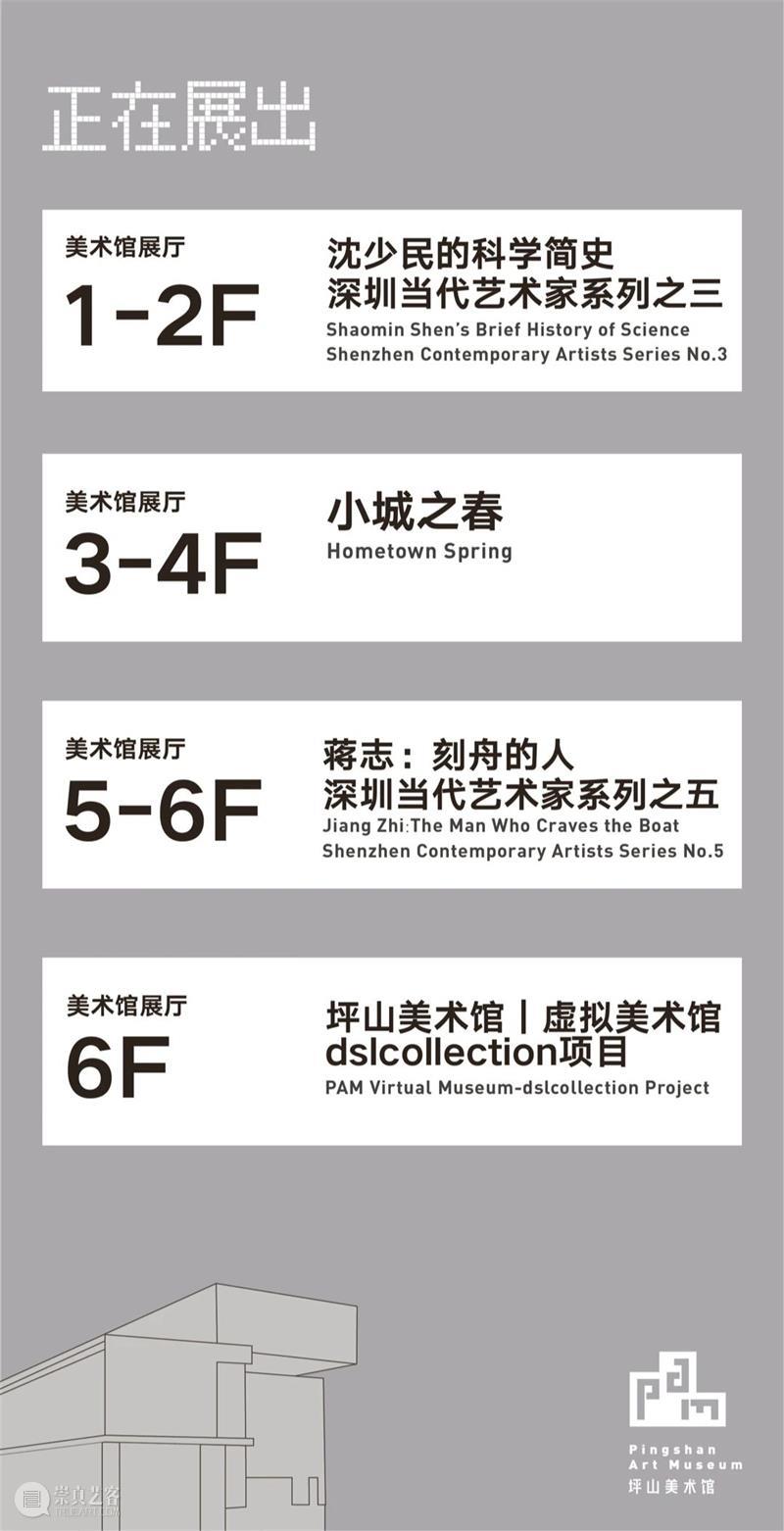
温馨提示
根据市疫情防控指挥部最新指示,即日起观众在坪山美术馆微信公众号预约后,经体温检测正常后进入场馆。各区域“同时在馆人数”达到上限后实施“出一进一”动态管理。在馆期间,请您全程规范佩戴口罩。坪山美术馆将根据疫情情况动态调整防控措施,敬请大家合理安排参观时间,错峰参观、分时预约、间隔游览。感谢您的理解与支持!
● 坪山美术馆采取限流开放,实行预约进馆制(可线上或现场扫码预约);
● 线上预约路径:关注坪山美术馆公众号-点击底部菜单栏“预约观展”并填写参观信息;
● 现场预约进馆:在美术馆入口处扫码登记,经测温正常后入馆参观;
● 预约限额、开放时段等信息以预约系统为准;
● 系统提前三天开放预约。

内容整理|米选萦
编辑|骆昱彤
审校|刘晓都 李耀
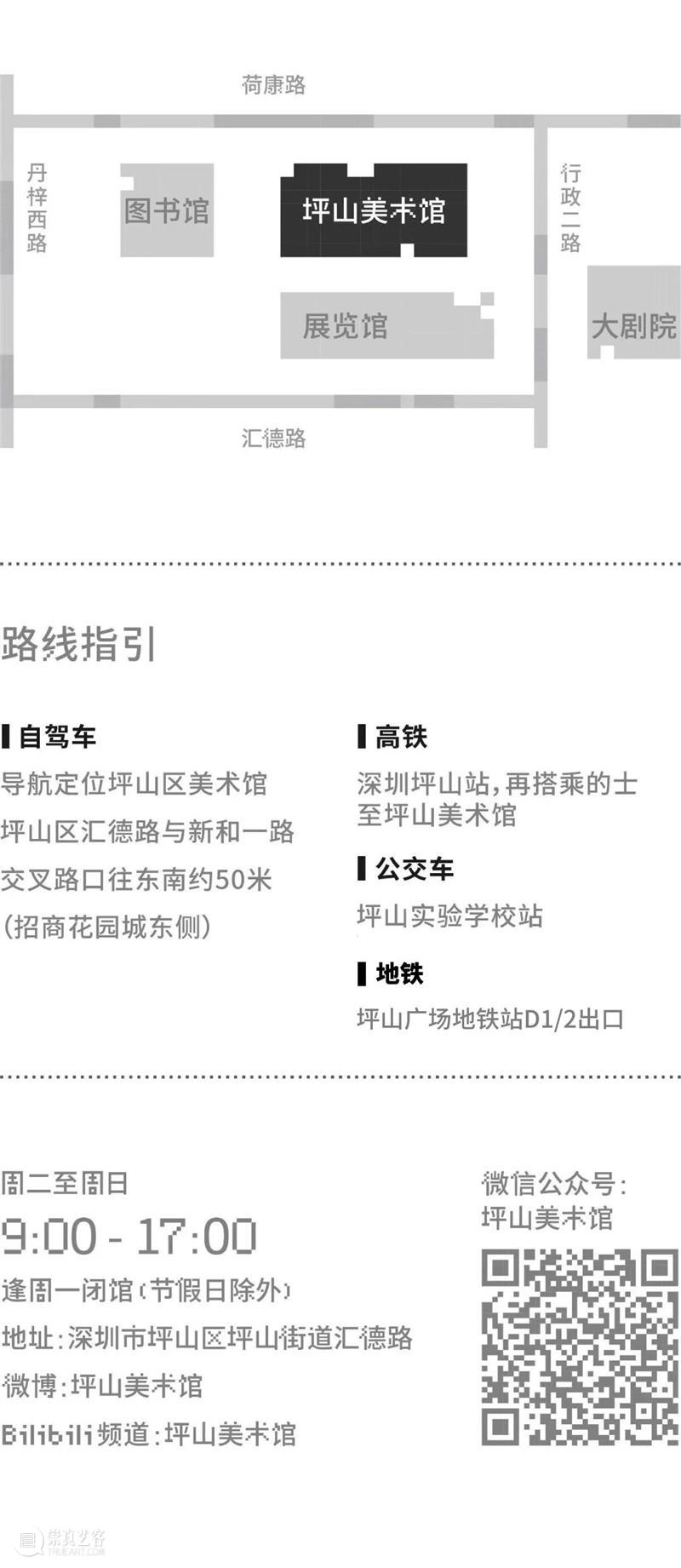


已展示全部
更多功能等你开启...





 分享
分享